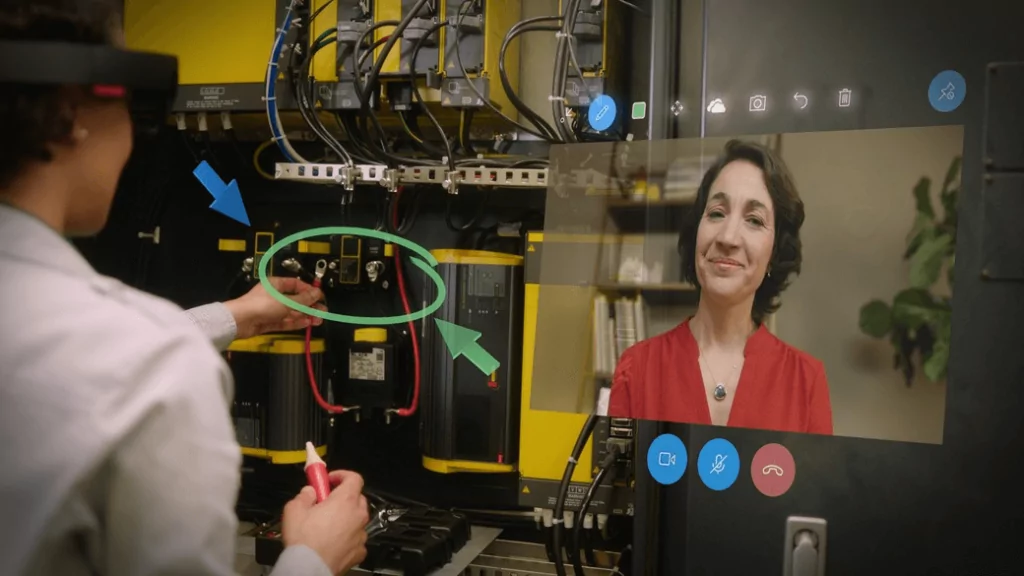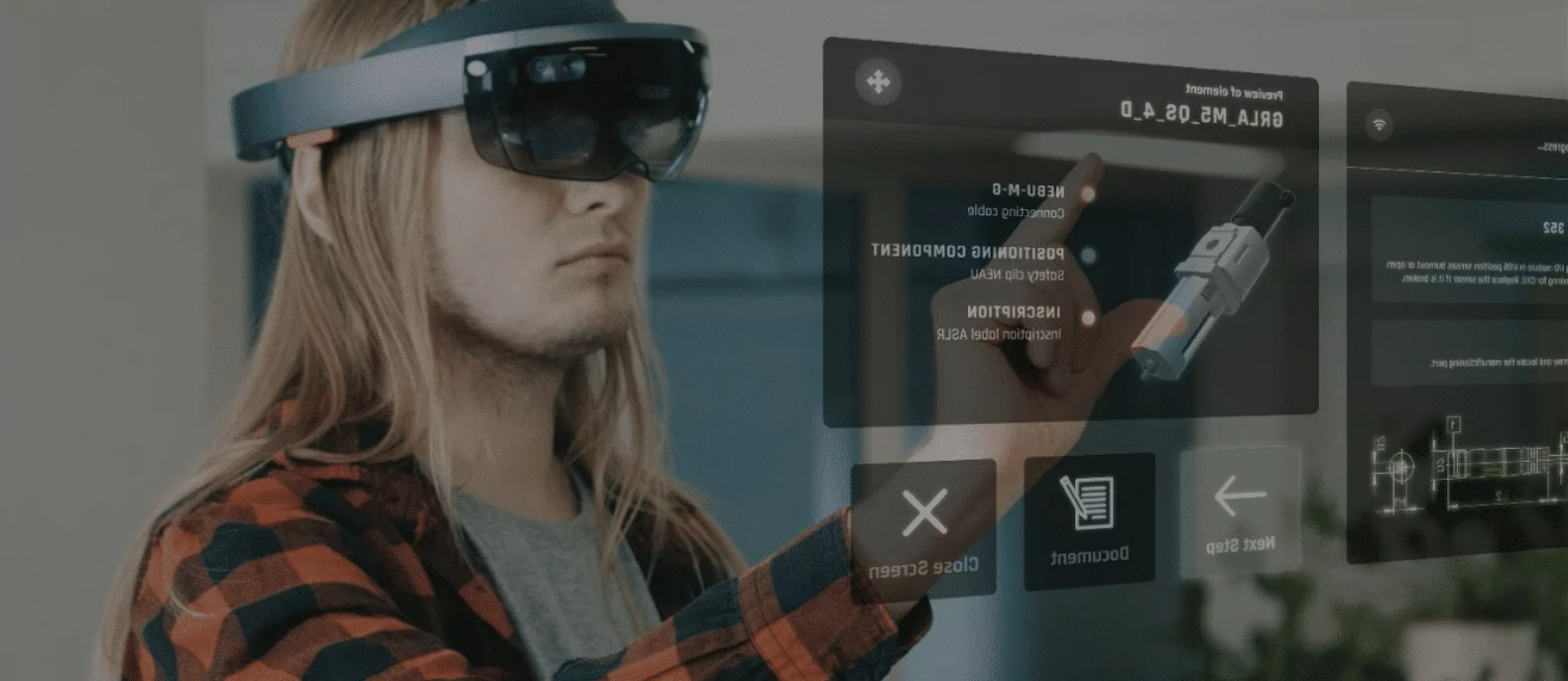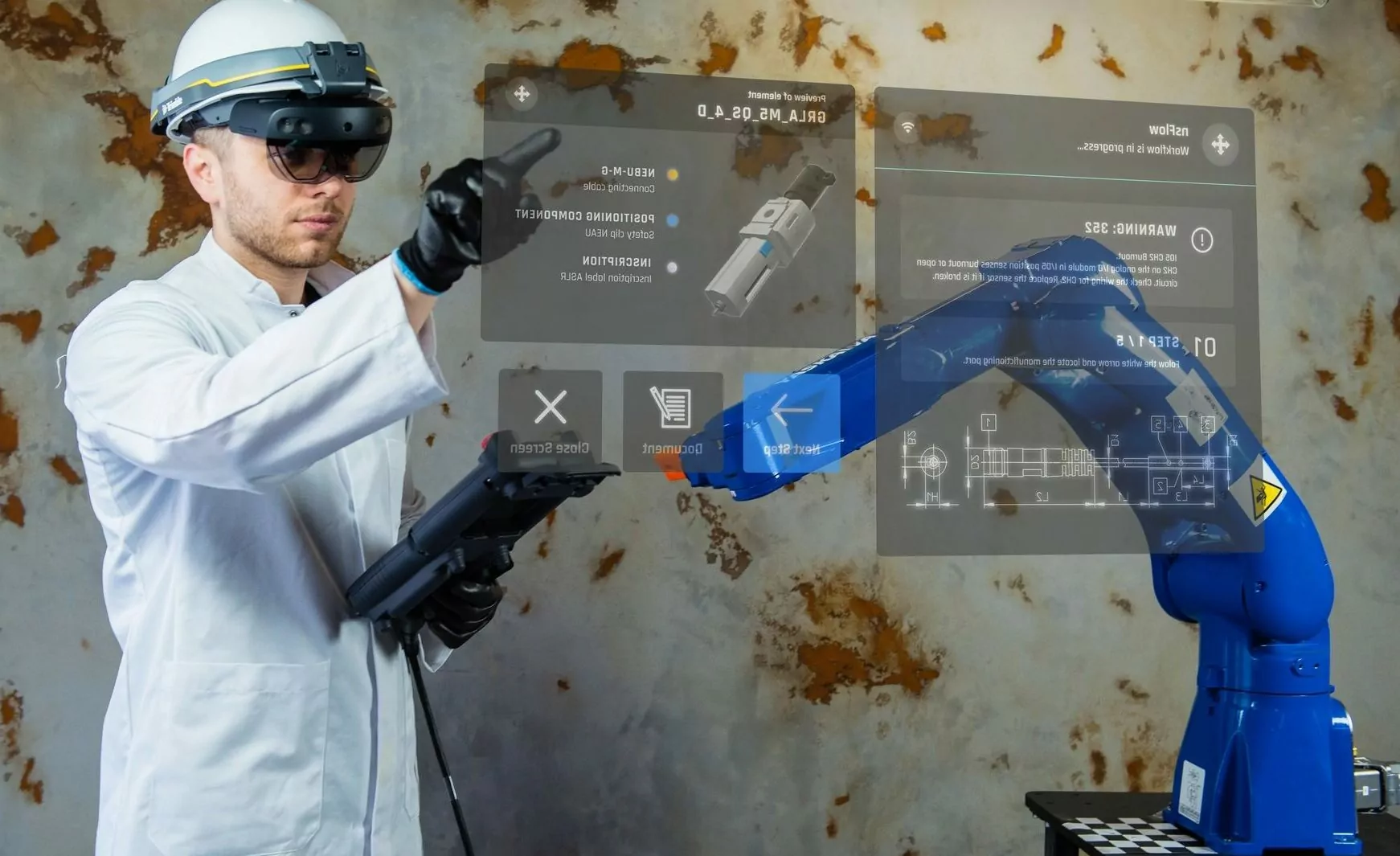Just a decade ago when you run into some dilemma – be it a leaky faucet, paper stuck in a printer, or a sudden need to impress somebody with your non-existing cooking skills… – you’d call the appropriate service, or your “expert” friend, or tried to do it or screw it on your own.

Nowadays there is an awesome alternative to that. Within a few clicks, you can find a real person showing how to do the thing you need step-by-step on YouTube. Thanks to a wide pool of video content that is easy to create and share, we can learn whatever, wherever and whenever we want.
But the bigger breakthrough in learning and training is yet to come.
Whereas today we still need to play an active role in knowledge acquisition, tomorrow – we’ll have relevant data in front of our eyes with minimum or zero efforts. This is already happening, so far within the industrial environment mostly, thanks to augmented reality (AR).
Let’s see if we’re on the same page first…
(skip this part if you know what augmented reality stands for)
Augmented reality represents a layer of computer-generated content displayed over the normal human field of view, which is perceived as a natural part of the environment. Aka terminator vision, if you like:

Unlike virtual reality, augmented reality doesn’t cut off a user from the real world. The user stays in his/her physical surrounding while benefiting from a computerized extension of it.
Almost everyone can try AR nowadays – by using smartphones or tablets. Wearable AR devices aren’t widely used yet, but they offer better AR experience by engaging the whole line of sight while being hands-free.
Most popular AR devices are wearable computer glasses, so-called – smart glasses. In terms of capacity, they aren’t much different from wearing a PC on your head. You’ve probably heard of some of them: Microsoft HoloLens, Vuzix, & Google Glass.
There are still some debates in wider circles regarding what AR can be used for, with entertainment, gaming and advertising prevailing (rolling my eyes).
We at NeuroSYS support more functional (and let’s be honest – more beneficial for humanity) ways of using AR. One of which is learning, corporate training and knowledge retention that I want to discuss in more details further on.
How augmented reality can benefit learning and knowledge retention?
Augmented reality provides users with relevant data that is automatically incorporated into their viewing area in real-time. This feature is used to create step-by-step visual instructions, with the active engagement of the surrounding: live pointers, explanatory data or guidance superimposed on physical objects:
In 2016 Accenture Labs together with Meta conducted high-level user research on the impact of augmented reality as a training tool. Around 100 participants (men and women of different age) were asked to build a simple Lego™ lighthouse set. One group received paper instructions, the other – AR instructions using static 3D visualization (with no motion), and another – AR instructions using dynamic 3D visualization (with motion cues). As the experiment revealed, users from the third group noticed mistakes 50 percent faster than those trained by other methods.
For more insights on the psychology of learning enhanced with augmented reality – check out this article (also by Accenture Labs).
We don’t have psychologists onboard, but we can offer you our tech-biz opinion on what makes AR so special when it comes to adopting it to training and knowledge retention processes:

#1 Better performance
Not only AR instructions proved to reduce the errors in procedural task performance. With AR learning becomes doing: training can take place on-the-job without blocking or slowing down business processes or production flows.
Great performance optimisation can be achieved by integrating AR applications with other external systems and devices. For instance, very often in practice operating a production line of, let’s say, ten machines requires an employee to go back and forth to a control terminal in order to check a status of one particular machine. With AR smart glasses there would be no need for that. The AR application can be integrated with the central system and display the necessary status info whenever the employee needs it (by scanning the machine’s barcode f.e.).
Moreover, by using AR solutions it’s also easy to monitor the performance, collect data and conduct its analysis to identify bottlenecks in the process and generate ideas for further improvements.
#2 Cost-effectiveness
There are plenty of examples of how AR investments turn to be ROI-positive. Here are just a few of them:
- By using augmented reality for ensuring a virtual presence of skilled employees, businesses can cut costs on bringing such specialists onsite. This is relevant for training a group of people in different locations, or when force-major problems occur in the field and require senior specialists to be present there. With AR even rare skilled specialist become available and share their knowledge and skills despite time differences or distance. This becomes especially crucial in times of high staff turnover.
- AR helps to recreate learning environments that are otherwise expensive (or impossible) to provide due to scarcity, distance, or complexity, f.e.: flight simulators for pilots or cosmonauts, surgical simulators, various AR models and simulators for industrial engineering and manufacturing.
- Smart glasses can help eliminate paper-based documentation or inconvenient usage of laptops/tablets on the field:
#3 Relevance and context
Information displayed by smart glasses or other AR devices can react to the changing environment and external triggers: location, verbal and gesture commands, QR code, physical objects and even noise around. This allows to expose step-by-step instructions depending on users’ progress:
#4 Mobility & hands-free usage
AR smart glasses display information in front of users’ eyes, allowing them to learn from any location while performing other tasks. This comes in handy for conducting hands-on training, for example, or in case of machinery breakdown. Instructions can be transmitted via AR device with no need to send a tutor or a tech rep onsite.

#5 Personalization
AR training materials can be personalized for every user, altered depending on the user’s progress etc. AR applications can substitute the repetitive tasks of a tutor connected with monitoring and evaluating every single learner, gathering and analysing statistics, which is a huge workload, especially when performed on a large scale, which leads us to the next point ↴
#6 Easy to scale
Instructions and workflows prepared for AR applications aren’t limited to any particular number of users (as long as they have access to AR devices), and thus, are easy to scale and adapt to changing business needs.
#7 Risk reduction
AR simulations can be used to reduce health and safety risks. This is relevant for training employees who are foreseen to be employed in hazardous working conditions or are expected to perform high-risk activities.
#8 Wider research scope
With the help of augmented reality, we can ‘see’ things that are normally hidden from our view.
For example, trainees can review 3D models of internal equipment components through AR smart glasses with no need to disassemble it for learning purposes.
Such a feature is also handy for people dealing with objects located underground, like in the case with utilities:
#9 No language barriers
Visual communication allows explaining things without using language. Visual AR guides are great for communicating in noisy or dark environments where text or sound instructions cannot be seen/heard. Or when dealing with illiterate users (which is still a case in rural industrial locations).
#10 Motivation and creativity booster
Augmented reality makes learning materials more attractive and fun to work with. Who doesn’t want to feel like Terminator or Iron Man while learning or working? Motivation and creativity get fostered, as AR is a great way to get trainees’ imagination and self-esteem flying.
To sum up…
AR has a big potential for transforming learning in general, as well as corporate training and knowledge retention. Due to still rather high costs of development and no standardization among AR software and hardware, this technology is spreading slowly among industrial giants that can afford it.
Currently, we are working on making AR more available, by moving it from the sphere of customized services to DIY zone. We believe that similar to videos that even a child can shoot nowadays (whereas a few decades ago it required certain skills and equipment), augmented reality can be created directly by users with no coding skills or special devices. Stay tuned and be the first to try the platform for codeless AR on nsflow.com (our spin-off venture).
Hope you find this useful and don’t hesitate to contact us in case you have any questions or wonder how AR can benefit your business.




